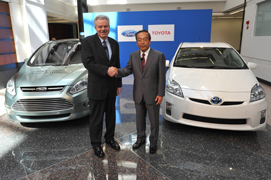 By John Addison (updated 8/23/11; original 8/22/11)
By John Addison (updated 8/23/11; original 8/22/11)
Look for Major MPG Gains in Ford F150 and Toyota Tacoma Trucks; Toyota Highlander and Ford Escape SUVs
Ford and Toyota– the world’s two leading manufacturers of hybrid vehicles –announce that they will equally collaborate on the development of an advanced new hybrid system for light truck and SUVs.
In the past, Ford licensed 21 patents from Toyota related to the hybrid drive system in exchange for patents relating to emissions technology. The licensing included a financial transaction. This new memorandum of understanding (MOU) creates the foundation for serious collaboration in new product development. This type of collaboration has been successful in the information technology field for decades, where core technology is jointly developed and then companies compete with final products in the market place. The term “coopetition” is often used.
Toyota has sold over 3 million hybrids, leading with the Prius, to achieve significant hybrid market share leadership. Ford has taken hybrid market share from Honda with the Ford Fusion Hybrid and achieved impressive SUV mileage with the Ford Escape Hybrid. Toyota, Ford and Honda dominate our list of the 10 Hybrids with Best Mileage.
Toyota has also partnered with Tesla to bring to market the exciting new 2012 Toyota RAV4 EV, a 100% electric full-function SUV. Ford and Toyota are expanding their use of advanced lithium batteries in new hybrids, plug-in hybrids and electric cars. The new powerful and fuel-efficient trucks and SUVs from this partnership will almost certainly use lithium batteries, thereby increasing lithium battery volume and lowering cost for all future hybrid and electric vehicles.
Both companies have been working independently on their own future-generation rear-wheel drive hybrid systems. The two now have committed to collaborate as equal partners on a new hybrid system for light trucks and SUVs. This new full hybrid powertrain will bring exceptional fuel efficiency improvements to a new group of truck and SUV. Ford and Toyota believe that their collaboration will allow them to bring these hybrid technologies to customers sooner and more affordably than either company could have accomplished alone.
Takeshi Uchiyamada, Toyota executive vice president, Research & Development, said: “In 1997, we launched the first-generation Prius, the world’s first mass-produced gasoline-electric hybrid. Since then, we have sold about 3.3 million hybrid vehicles. We expect to create exciting technologies that benefit society with Ford – and we can do so through the experience the two companies have in hybrid technology.”
The two companies also agreed to work together on enablers to complement each company’s existing telematics platform standards, helping bring more Internet-based services and useful information to consumers globally.
The two companies will bring the best of their independently developed hybrid powertrain technology and knowledge to a new co-developed hybrid system, which will be used in rear-wheel-drive light trucks arriving later this decade. The MOU states that Ford and Toyota will:
- Jointly develop as equal partners a new rear-wheel drive hybrid system and component technology for light trucks and SUVs
- Independently integrate the new hybrid system in their future vehicles separately
Ford CEO Alan Mulally and Toyota President Akio Toyoda
“By working together, we will be able to serve our customers with the very best affordable, advanced powertrains, delivering even better fuel economy,” said Ford President and CEO Alan Mulally. “This is the kind of collaborative effort that is required to address the big global challenges of energy independence and environmental sustainability.”
Toyota President Akio Toyoda added: “Toyota is extremely proud to join Ford in developing a hybrid system for pickup trucks and SUVs. Not only is this tie-up clearly one aimed at making automobiles ever better, it should also become an important building block for future mobility in the U.S. By building a global, long-term relationship with Ford, our desire is to be able to continue to provide people in America automobiles that exceed their expectations.”
This rear-wheel-drive hybrid system will be based on an all-new architecture to deliver the capability truck and SUV customers demand while providing greater fuel economy.
While the rear-wheel-drive hybrid system will share significant common technology and components, Ford and Toyota will individually integrate the system into their own vehicles. Each company also will determine the calibration and performance dynamics characteristics of their respective light pickups and SUVs.
Telematics Partnership for Better Safety and Infotainment
In addition, as telematics plays an increasingly more important role in the in-car experience, both companies have agreed to collaborate on standards and technologies needed to enable a safer, more secure and more convenient in-car experience for next-generation telematics systems. The telematics collaboration relates only to standards and technologies, and each company will continue to separately develop their own in-vehicle products and features.
Ford has partnered with Microsoft to more quickly bring better telematics to its vehicles. Now Ford will also partner with Toyota. “Ford has made tremendous progress in the area of telematics,” Kuzak said. “We have unique and very good solutions today with SYNC and MyFordTouch. Working together on in-vehicle standards can only enhance our customers’ experience with their vehicles.”
Uchiyamada added: “Toyota has also invested heavily in telematics in various countries around the world, with services like the G-BOOK and G-Link. In the U.S., we have just introduced the accessible, easy-to-use Entune. By sharing our know-how and experience, we would like to offer even better telematics services in the future.”
